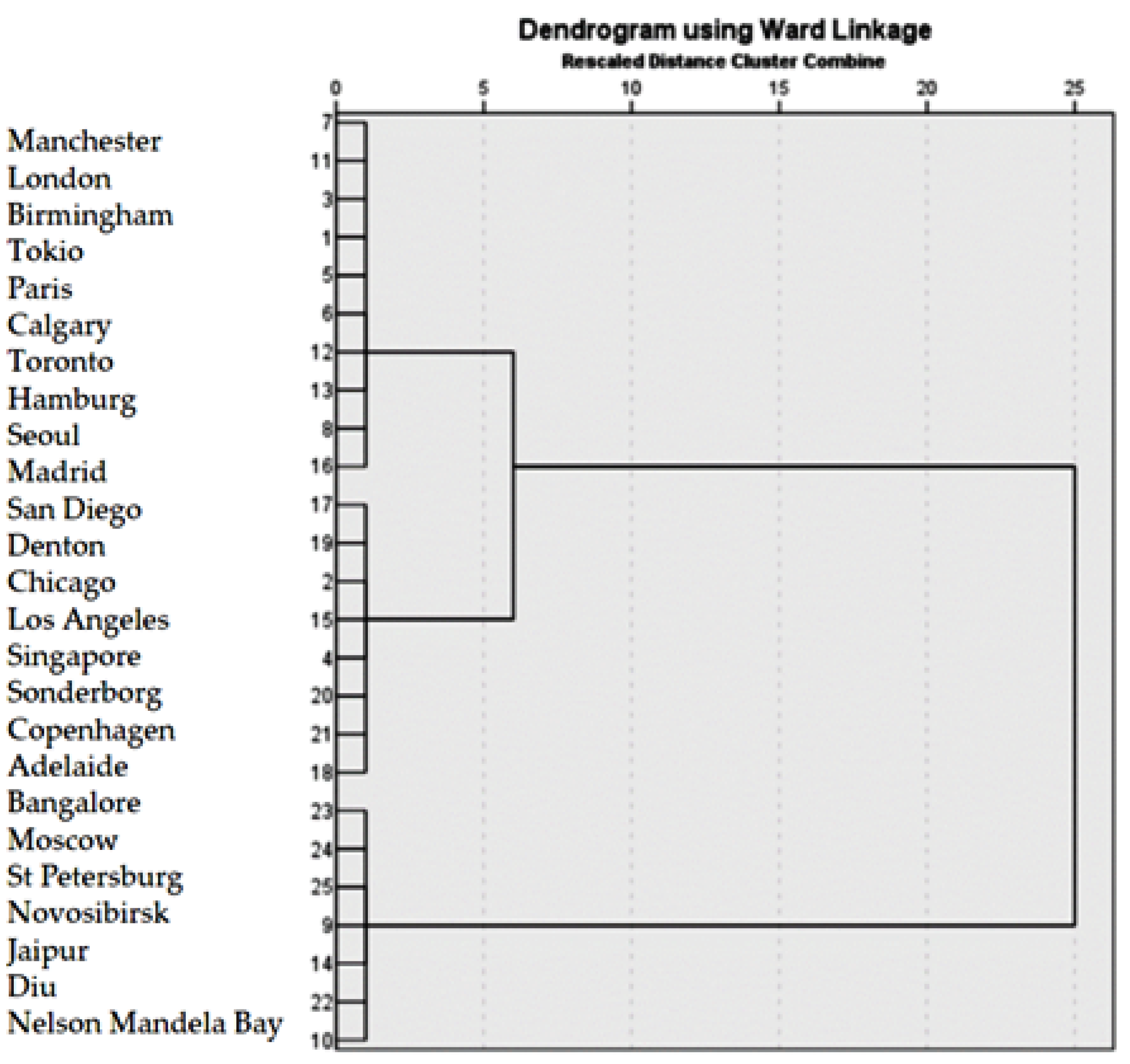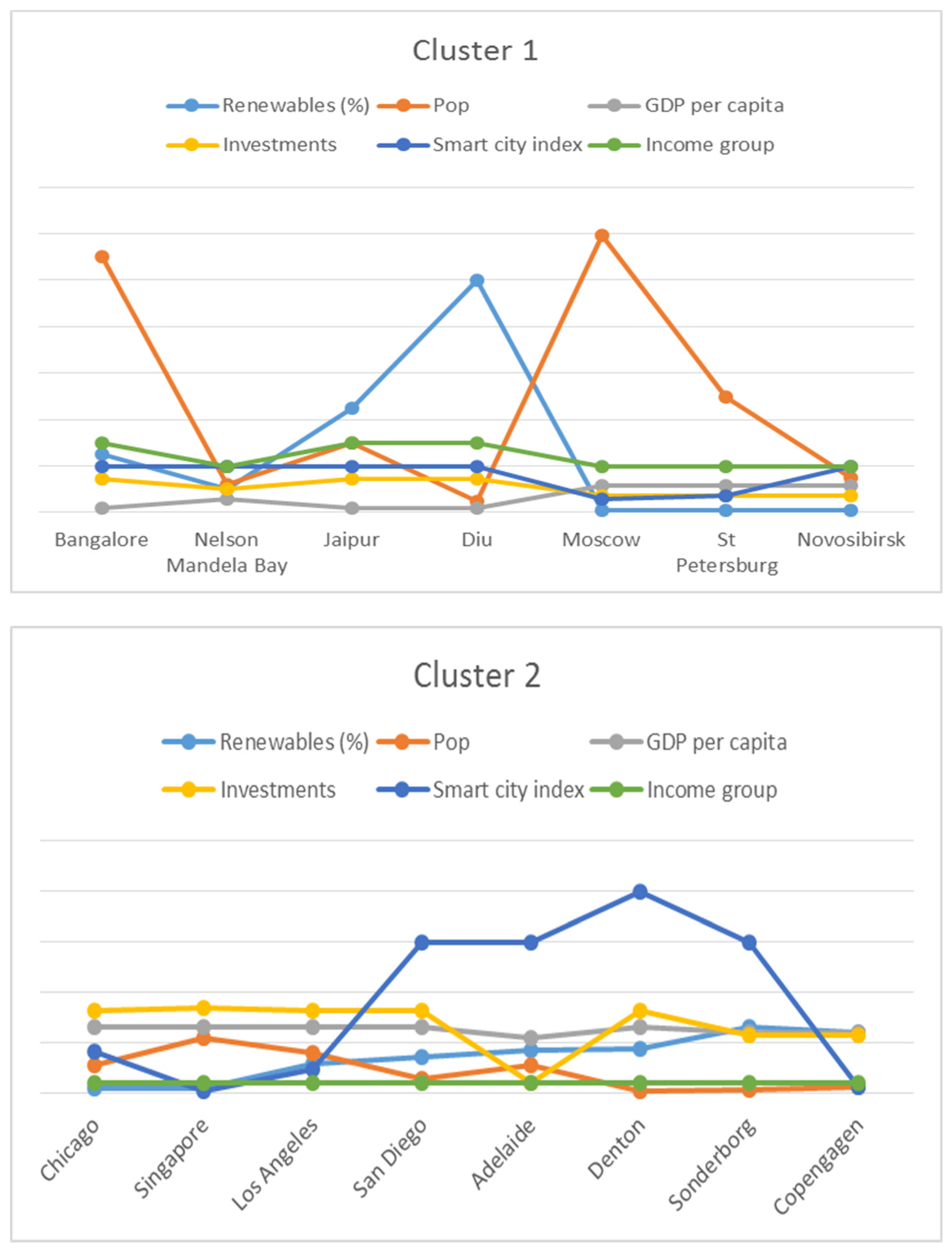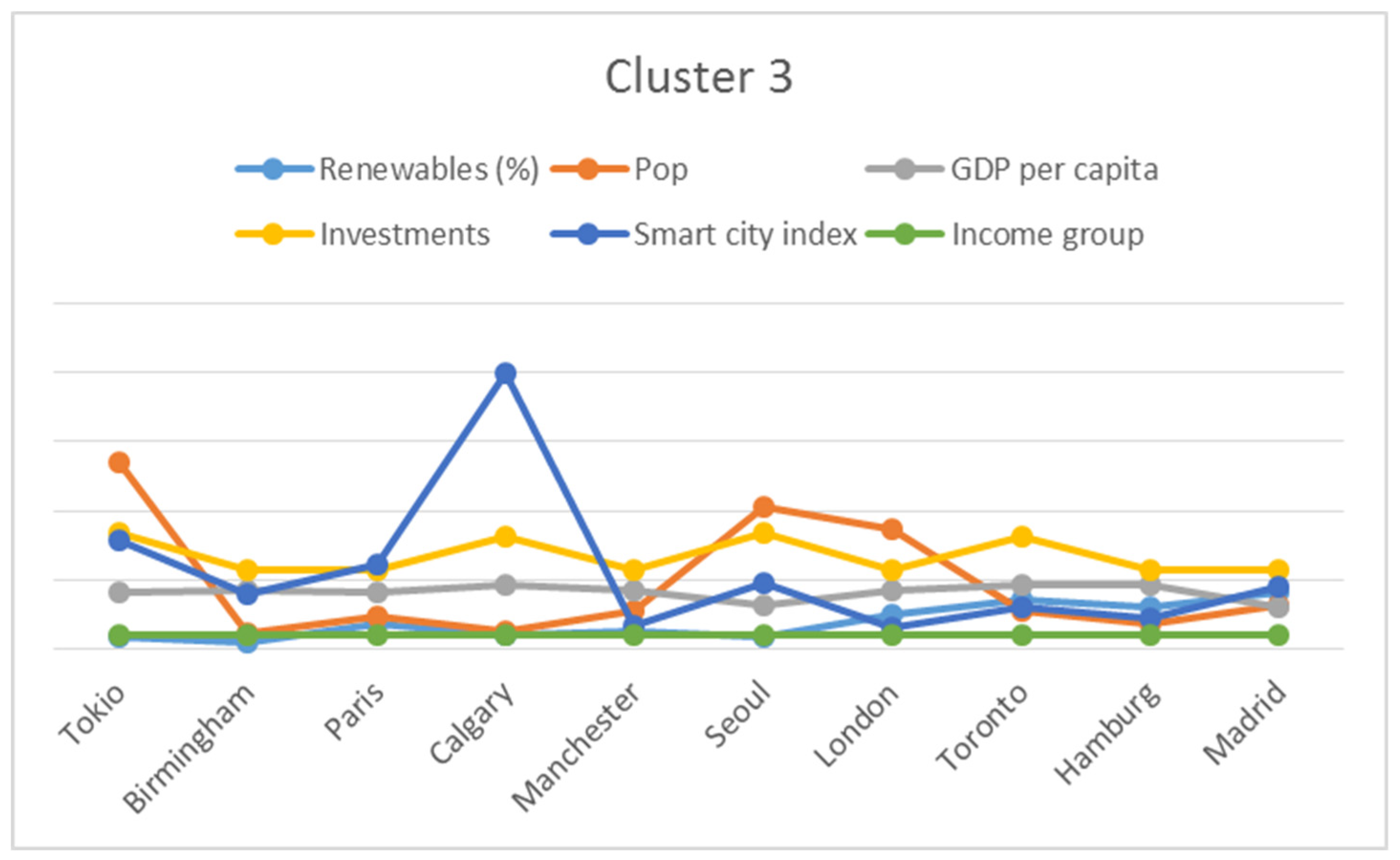3.2.1. City Goals, the Most ‘Clean’ Cities, Successful and Unsuccessful Cases of RES in Cities
According to IRENA studies [
13], the number of cities have set renewable energy targets, but over 80% of these cities are in Europe and North America. At the same time, we projected that Asia and Africa will experience the fastest growth in both urban population and energy demand.
Cities with renewable energy targets most often fall within the population range of 100,000 to 500,000 inhabitants. Most of the large cities and metropolitan areas that have set targets for the use of renewable energy sources currently have less RES shares and targets are also less than in small cities.
Most of the cities with targets to increase the share of energy from renewable energy (551 out of 671 cities, or 82% of the total) located in countries with a high GDP per capita, which indicates a clear correlation at present between cities with targets for the use of renewable energy sources and their economic status.
The world experience of using RES in cities is quite diverse. European cities, cities in the USA, Canada, India, and other countries on different continents are actively investing in the development of renewable energy and setting goals to achieve the maximum of possible share of renewable energy sources in the total share of energy sources. We consider several examples of the transition to renewable energy in the world.
For a clearer picture, we use the example of cities from different groups in terms of the urban population NS geographical locations. We consider the two most “clean” cities, where the use of renewable energy sources reaches 100%. These are the cities of Diu in India and Georgetown, Texas (Georgetown, TX, USA) in the USA. Below is a comparison in
Table 1 of these two cities.
Diu became the first city in India to run entirely on solar energy during the day. Electricity comes from two solar parks with an area of 0.2 square meters km and from panels on the roofs of 112 public institutions.
Together two parks have a capacity of 10.27 MW and operate about 12 h a day. Demand in this 42 sq. km with a population of 52,074 people ranges from 5 to 7 MW. This means that during the day, the sun illuminates all homes, centrally air-conditioned resorts, Diu’s 60-bed hospital, government buildings, air-conditioned office buildings, and ice factories and fish stores, which are its main source of energy consuming industries.
Attempts to turn Diu towards the sun began in 2013 when the first of its two solar parks were authorized by India’s Central Electricity Authority. Commissioned by 2015; the second stage-by 2016. The union territory also means that Diu is under the control of the central government, which has made it easier to plan, finance, find land, and implement the solar parks project.
Georgetown didn’t switch to wind and solar because that was the first goal. Wind and solar power contracts were the best deals in 2013 and 2014 to ensure long-term price stability and reduce regulatory risk. By switching to 100% renewable energy, Georgetown reduces pollution and conserves water at a competitive cost. Georgetown Utility Systems is committed to competitively priced electricity with low regulatory and price risk for its customers. The long-term, fixed cost and zero carbon risk associated with solar and wind power contracts make renewables the right choice.
Clearway Energy and EDF Renewable Energy are the largest contracted energy providers. The solar farm is located in West Texas near Fort Stockton, and the wind farm is located in the Texas area, about 50 miles west of Amarillo. Georgetown’s RES produces more energy than customers need. Projected energy production for 2019 was almost twice higher than consumption.
However, at first glance, the absolutely successful case of 100% provision of the city with RES has its drawbacks. Contracts concluded for fixed prices for the supply of electricity have become uncompetitive over time. In addition, due to inaccurate calculations, the city purchases more energy than it needs, forcing it to sell excess energy at unprofitable prices. The city is losing taxpayer money, resulting in dissatisfaction among the city’s residents.
Based on the analysis of these cities, it can be argued that the date of the city’s foundation does not have a special influence on the formation of the energy balance structure. Both cities are small in terms of population, have solar potential and have approximately the same number of hours of sunshine. At the same time, if Diu is completely provided with solar energy during the daytime, then in Georgetown, energy is produced by both solar power plants and wind turbines.
An important difference is that Georgetown, at the initiative of the authorities, became a city that consumes renewable energy, and the result of the energy transition in Diu is the initiative and support of the central government of India. From this we can conclude that projects can be initiated by both the city and the state. Further, we will consider cities with medium and large populations.
Cities around the world are actively using renewable energy to meet the needs of urban residents. This paragraph considers cities on different continents (Australia, Europe, North America, and Asia) to get the most complete picture. The population of each of the cities under consideration is more than 1.8 million people and up to 10.3 million people.
Table 2 presents data on the population, the share of solar and wind energy, as well as the total share of RES of the following cities for 2019: Adelaide (Australia), Hamburg (Germany), Toronto (Canada), Seoul (South Korea), London (England), Madrid (Spain).
All cities presented in the table have different levels of population and different share of RES. At the same time, all countries in which cities are located have a high level of GDP PPP. There is no visible relationship between the share of solar and wind energy in the total share of renewable energy used in the considered cities.
Adelaide for 2019 had a share of RES of 42.2%, provided only by solar and wind energy. However, in the 2019 plans, contracts have been awarded that will allow for a transition to 100 percent renewable energy that will power the City of Adelaide, including the Adelaide Aquatic Center, parks, warehouses and buildings, and Adelaide’s historic City Hall. With the new systems that were installed in 2019, the city of Adelaide’s total solar capacity exceeded 1.1 megawatts.
Collectively, installed solar power provides approximately 12 percent of the electricity consumed by all municipal buildings combined. It is equivalent to the power used by 333 average houses. This project saves about $300,000 on electricity and avoids about 760 tons of carbon dioxide emissions per year. This is the equivalent of using 302 gasoline-powered vehicles throughout the year.
Wind power, under a contract awarded in 2019, will supply from the Clements Gap wind farm in northern South Australia and two new solar farms in Eyre Peninsula (Streaky Bay) and South East (Coonalpyn) that are under development. Between 2007 and 2018, Adelaide’s resident population grew by 33 percent, student enrollment increased by 37 percent, gross regional product increased by 33 percent, and urban population increased by 43 percent. Despite these facts, and the significant increase, the City of Adelaide’s total carbon emissions have fallen by 15 percent.
Adelaide responsibly pursues plans to reduce harmful emissions into the atmosphere, even as the city grows. It mainly uses solar energy and wind energy to achieve the desired result. And the transition to 100% supply of VI energy is already in the plans. Hamburg is a well-known port city in Germany, which actively uses different types of renewable energy. It reconstructs unused objects into generation ones. For example, in the Hamburg district of Wilhelmsburg, a 42-m-high anti-aircraft bunker was turned into an energy center. It now generates power and heat with a biomass power plant, a solar thermal system, and a water tank. When completed in 2015, the bunker could provide heat for up to 3000 homes and electricity for about 1000 households.
In the same area, the Algenhaus (lit. “house of algae”) has large bio-reaction water tanks along its facades, in which algae power the building through biomass production. And the former landfill has been converted into another energy hub, supplying wind and solar energy to around 4000 homes. This unique experience in the reconstruction of unused capacities can be successfully applied both in other European cities and around the world.
Toronto has a different experience: In 2013, the City Council passed a requirement that all new city-owned buildings generate at least five percent of their energy used from renewable energy sources. The use of solar photovoltaic, solar thermal energy, geothermal energy and biomass contributes to the achievement of urban environmental, energy and economic goals.
The City has mandated that renewable energy systems be installed in all city buildings where possible by 2020. Over the past 20 years, more than 50 renewable energy systems have been installed on buildings and facilities in the city. Two programs were organized to implement the plan and they started their work in 2012 and 2013. Solar panels of standard and micro sizes are installed on city buildings.
Based on the study of unsuccessful projects in RES, it is possible to work out in advance those aspects of the implementation of projects for the introduction of RES, that may turn out to be weak. Solar energy generation projects have been launched in West African countries. The potential of the projects was huge. However, most of the implemented projects have fallen into disrepair due to lack of proper maintenance, cleaning (solar panels must be cleaned of dirt falling on them) and repairs. But the method of managing the above processes was not developed. So, some projects were closed without being built, while others were closed during work. In addition to the loss of resources: time and money, this situation has led to distrust of renewable energy among the governments of developing countries in West Africa, and now the prospects for renewable energy in Africa are limited to this.
There is a city in Abu Dhabi that was originally designed and built in such a way that it consumed energy only from renewable energy sources. This is the city of Masdar, built for less than 50 thousand inhabitants and intended as a center for innovative technologies. It originally had its own branch of the University of Massachusetts. About 1.5 billion dollars was invested in the construction of the city. The city remains deserted; it has not become a center of attraction for people. This situation allows us to think about not building new cities but making changes in existing cities: using combined energy, or completely converting to renewable energy.
So, the considered unsuccessful projects show that it is very important to treat calculations and planning, building roadmaps, and organizing related processes responsibly. In this part of the research we examined various cases: small towns with fully renewable energy, large cities and megacities using renewable energy from 8% to 46% in the total share of the energy balance, as well as projects in which the use of renewable energy did not bring the expected results. Next, we will consider what prospects renewable energy has in Russian cities.
3.2.2. Peculiarities of Russian Cities Energy Supply
A significant difference between the Russian city energy supply system and the European one heating systems, the so-called combined heat and power plants (CHP) approved for operation in the 1920s in the USSR. CHP plants are optimal for Russia due to the following features:
Cold climate in the country (northern and polar zone);
High tariffs when switching to a stand-alone system;
Major cities are located in the cold climate zone;
Large area of the country;
Uneven population density.
CHPPs in Russia are quite worn out, which necessitates renovation.
In the most cities of Russia, due to the widespread distribution of central heating and CHPPs in general, main gas, the end consumer (household, production) receives the finished product: hot water, heating, electricity. Apartment buildings designed and built in the 20th century in Russia, taking into account the central energy supply, do not provide for their own boiler houses. In this regard, the transition to autonomous power supply is a rather expensive and labor-intensive process.
The above factors for the availability of infrastructure for the energy supply of cities impose restrictions on the use of renewable energy sources in these areas. Despite this, there is an opportunity to use renewable energy sources for districts and cities under construction.
In most European cities, as well as in the US, the government sells the energy carrier directly to the consumer. And already the consumer (household, production) transforms the carrier into a product, through established systems (boilers, etc.). States actively support the transition to more environmentally friendly fuel through subsidies in the amount of more than 15% of the cost of equipment. These factors make switching to cleaner fuels less expensive and easier for most European cities.
At the same time, in Europe there are countries with centralized heating. Some of these systems have been converted to RES. Renovating the entire heating system and switching to another energy source is an expensive process that requires a large amount of initial investment. In Europe, the process of transition to renewable energy has actively begun since the beginning of the 21st century, thanks to which many countries have a ready-made system for the production, transmission, and use of energy from renewable sources, that is, infrastructure. In the Russian Federation, on the contrary, not enough attention was paid to the direction of renewable sources. Only hydro power has been developed: in 2015, the installed capacity of hydro-electric power plants (HPPs) was 20.4% of the installed capacity of UES power plants in Russia, and generation was 15.57% of the total. However, if we evaluate the power in actual terms, then it remained at the same level for five years. It can be concluded that the volume of investments in infrastructure for the development of RES is insufficient [
19]. The type of energy supply system in the city: private or central, as well as the presence of a certain energy supply infrastructure in the city, have a key influence on the choice of energy source.











